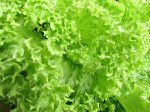Common physiological disorders in cucumbers
Physiological disorders caused by low temperatures
Low temperatures injury only occurs with fruit that are in storage (either in transit or in storage rooms). Small circular pits each 3-9mm in diameter and up to 1 mm deep appear. They can coalesce to form large irregular sunken areas. The minimum temperature that cucumber fruits should be stored is 12 °C. Risk to injury increases below 12 °C. Increasing the humidity also reduces the chance of injury.
Guttation salt injury
Guttation is the accumulation of sell sap on the outside of the leaf margin. Guttation is caused by high humidity and insufficient ventilation in greenhouses. Although guttation may appear in the mornings, it should not stay on the leaf margin during the day especially during hot periods. The evaporation of the sap causes a buildup of salts that are left behind. The high concentration of the salt damages the leaf tissue resulting in necrosis of the leaf margin. In severe cases the leaf dies.
Ribbed and spiny cucumbers
Ribbed and spiny cucumbers develop under high humidity and insufficient ventilation in the greenhouse. Although ribbed and spiny cucumbers do not lose much market value, the spines can cause some damage to other cucumbers. It is important to ventilate from 08H00 to at least 18H00 in summer and 09H00 to 16H00 in the winter.
Crooking the most common physiolocial disorder
Crooking has many causes. A cucumber fruit that is crooked loses its market value completely. It is important to remove crooked fruit from the vine before they mature. Some growers argue that there is a market for crooked cucumbers, however, the loss in growth and the amount received for the low grade product cannot be profitable. Crooking can be caused by:
- A leaf or stem can interfere with the growth of the young fruit by damaging the growing tissue. The damage tissue forms a “callus’ which cannot develop as fast as the rest of the fruit causing the fruit to bend like a banana. The fruit is unmarketable.
- Flower petals can also get stuck on the spines of leaves or stems or on a neighbouring fruit.
- Excessive high temperatures, low humidity, poor nutrition and poor ventilation also results in crooked fruit.
- Plusia looper, White fly, red spider and thrips can cause crooked fruit since they damage the developing tissue of the young fruit at an early age when they are soft.
Mechanical injury during handling
Although not a physiological disorder in the true sense, it does cause physiological damage. After the fruit is harvested they are prone to mechanical injury. Any slight bruise can develop into a water soaked blemish which reduces its market and tarnish the brand name under which it was sold. Either market your product with no branding and leave the branding to the distributor or brand your packaging but use packaging that protects the product sufficiently



